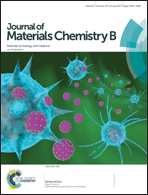A general strategy for generating gradients of bioactive proteins on electrospun nanofiber mats by masking with bovine serum albumin†
Abstract
Electrospun nanofibers are widely used in tissue engineering owing to their capability to mimic the structures and architectures of various types of extracellular matrices. However, it has been difficult to incorporate a biochemical cue into the physical cue provided by the nanofibers. Here we report a simple and versatile method for generating gradients of bioactive proteins on nanofiber mats. We establish that the adsorption of bovine serum albumin (BSA) onto nanofibers is a time- and concentration-dependent process. By linearly increasing the volume of BSA solution introduced into a container, a gradient in BSA is readily generated across the length of a vertically oriented strip of nanofibers. Next, the bare regions uncovered by BSA can be filled with the bioactive protein of interest. In demonstrating the potential application, we examine the outgrowth of neurites from dorsal root ganglion (DRG) isolated from chick embryos and then seeded on aligned polycaprolactone nanofibers covered by nerve growth factor (NGF) with a uniform coverage or in a gradient. In the case of uniform coverage, the neurites extending from DRG show essentially the same length on either side of the DRG cell mass. For the sample with a gradient in NGF, the neurites extending along the gradient (i.e., increase of NGF concentration) were significantly longer than the neurites extending against the gradient.



 Please wait while we load your content...
Please wait while we load your content...